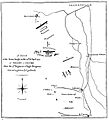Battle of Villers-en-Cauchies facts for kids
Quick facts for kids Battle of Villers-en-Cauchies |
|||||||
|---|---|---|---|---|---|---|---|
| Part of the War of the First Coalition | |||||||
|
|||||||
| Belligerents | |||||||
| Commanders and leaders | |||||||
| Strength | |||||||
| 7,000 | 300 | ||||||
| Casualties and losses | |||||||
| 1,200 killed, wounded or captured, 5 cannons | 95 killed, wounded or missing | ||||||
The Battle of Villers-en-Cauchies took place on April 24, 1794. It was a surprising fight during the French Revolutionary Wars. A small group of British and Austrian cavalry soldiers defeated a much larger French army. This battle happened near Villers-en-Cauchies, a town in France, about 15 kilometers (9 miles) south of Valenciennes.
Why the Battle Happened
The War in 1794
In 1794, a big war was happening in Europe. It was called the War of the First Coalition. Many countries, like Great Britain and Austria, were fighting against the French Republic. This part of the war, called the Flanders Campaign, took place in what is now Belgium and northern France.
Siege of Landrecies
The main army of the Coalition (British and Austrian forces) was led by Prince Josias of Saxe-Coburg-Saalfeld. They were trying to capture a French town called Landrecies. To protect their siege, the Coalition army spread out in a wide circle.
French Plan to Attack
On April 23, the French army, led by General Chapuy, gathered a large force. Their goal was to cut off some of the Coalition troops. They had about 7,000 soldiers, including both infantry (foot soldiers) and cavalry (soldiers on horseback). The French moved in several groups, pushing back the Austrian outposts. They wanted to break the communication lines between different parts of the Coalition army.
Allied Response
When the Duke of York, a British commander, heard about the French movements, he sent an Austrian general named Rudolf von Otto to check things out. General Otto took a small group of cavalry, including Austrian Hussars and British Light Dragoons. He quickly realized the French force was huge. He pulled back and asked for more soldiers. Ten more cavalry squadrons were sent to help him, but they didn't arrive until after dark. So, the attack was planned for the next morning.
The Battle Begins
Otto's Bold Plan
On the morning of April 24, General Otto learned that the French were still in the same spot. He decided to attack right away, even though his forces were much smaller. He had only about 300 cavalry soldiers ready to fight. These included two squadrons of Austrian Hussars and two squadrons of British Light Dragoons.
The Charge
At 7:00 AM, Otto's small group rode towards the French. They were trying to get around the French right side. They soon spotted French cavalry and infantry. The Allied cavalry, thinking they had more support behind them, charged. The French cavalry quickly rode away, leaving their infantry exposed.
Facing the French Infantry
The French infantry, seeing themselves alone, quickly formed a square shape. This was a common defense tactic against cavalry. They started firing at the charging Allied cavalry. Even though they were being shot at, the British and Austrian cavalry kept going. They charged right into the French square, breaking through one side. They even captured four French cannons!
French Retreat
Some of the French infantry ran away. The rest kept fighting, but the Allied cavalry charged again. This time, the remaining French infantry broke and ran. These French soldiers had been defeated in the same area just a few days before, so they were already feeling discouraged.
The Surprising Victory
General Otto later said that if his main support group had joined the charge, the French would have been completely destroyed. But for some reason, the larger British cavalry group had stopped. This meant that the entire attack was carried out by a very small group of Allied soldiers against a much larger French force.
After the Charge
The Allied cavalry chased the fleeing French soldiers for about 8 kilometers (5 miles). Seeing their comrades defeated, two large French groups on the sides of the main column quickly retreated. Otto's men then pulled back to regroup. However, the French cavalry, led by General Bonnaud, counterattacked. Luckily, Otto received reinforcements: three more squadrons of Austrian Hussars. With the help of some Austrian cannons, the French were forced to retreat again.
What Happened Next
Re-establishing Communications
After the battle, General Otto helped re-establish communication lines between the different Allied armies. Other Allied forces also pushed back the French in different areas. The French retreat became a complete rout, with their artillery drivers panicking and abandoning their cannons.
French Losses
The French commander, General Pichegru, tried to downplay the French losses. He even made up stories about French bravery. However, reports show that the French lost many soldiers. Out of about 7,000 men, they had around 1,200 killed, wounded, or captured. They also lost 5 cannons.
Allied Losses
The British and Austrian forces had far fewer casualties. The Austrians lost only 10 killed or wounded and 10 missing. The British had 58 killed and 17 wounded. This shows how successful the small Allied cavalry force was.
Awards for Bravery
Because of their amazing bravery in this battle, eight British officers received special gold medals from Emperor Francis II of Austria. Later, in 1801, these same officers were made Knights of the Military Order of Maria Theresia, a very high honor. These officers included Major William Aylett and Captain Robert Pocklington. Only nine of these special medals were ever made.
Images for kids


